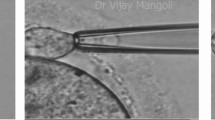Abstract
Purpose
To present a live birth resulting from serial vitrification of embryos and pre-implantation genetic diagnosis (PGD).
Methods
A 31-year-old with primary infertility, fragile-X premutation, and decreased ovarian reserve (DOR) (baseline FSH level 33 IU/L), presented after failing to stimulate to follicle diameters >10 mm with three cycles of invitro fertilization (IVF). After counseling, the couple opted for serial in-vitro maturation (IVM), embryo vitrification, and genetic testing using array comparative genomic hybridization (aCGH) and PGD. Embryos were vitrified 2 days after intra-cytoplasmic sperm injection (ICSI). Thawed embryos were biopsied on day-three and transferred on day-five.
Results
The couple underwent 20 cycles of assisted reproductive technology. A total of 23 in-vivo mature and five immature oocytes were retrieved, of which one matured in-vitro. Of 24 embryos, 17/24 (71 %) developed to day two and 11/24 (46 %) survived to blastocyst stage with a biopsy result available. Four blastocysts had normal PGD and aCGH results. Both single embryo transfers resulted in a successful implantation, one a blighted ovum and the other in a live birth.
Conclusions
Young patients with DOR have potential for live birth as long as oocytes can be obtained and embryos created. Serial vitrification may be the mechanism of choice in these patients when PGD is needed.
Similar content being viewed by others
References
Aanesen A, Nygren KG, Nylund L. Modified natural cycle IVF and mild IVF: a 10 year Swedish experience. Reprod Biomed Online. 2010;20(1):156–62.
Ao A, Jin S, Rao D, Son WY, Chian RC, Tan SL. First successful pregnancy outcome after preimplantation genetic diagnosis for aneuploidy screening in embryos generated from natural-cycle in vitro fertilization combined with an in vitro maturation procedure. Fertil Steril. 2006;85(5):1510-e9–11.
Ao A, Zhang XY, Tan SL. First successful pregnancy following PGD for chromosome translocation on embryos generated from in-vitro matured oocytes: a case report. Reprod Biomed Online. 2011;22(4):371–5.
Buckett WM, Chian RC, Dean NL, Sylvestre C, Holzer HE, et al. Pregnancy loss in pregnancies conceived after in vitro oocyte maturation, conventional in vitro fertilization, and intracytoplasmic sperm injection. Fertil Steril. 2008;90(3):546–50.
Fridén B, Hreinsson J, Hovatta O. Birth of a healthy infant after in vitro oocyte maturation and ICSI in a woman with diminished ovarian response: case report. Hum Reprod. 2005;20(9):2556–8.
Gallagher A, Hallahan B. Fragile X-associated disorders: a clinical overview. J Neurol. 2012;259(3):401–13.
Gleicher N, Barad DH. The FMR1 gene as regulator of ovarian recruitment and ovarian reserve. Obstet Gynecol Surv. 2010;65(8):523–30.
Gleicher N, Kim A, Weghofer A, Barad DH. Differences in ovarian aging patterns between races are associated with ovarian genotypes and sub-genotypes of the FMR1 gene. Reprod Biol Endocrinol. 2012;10:77.
Gleicher N, Weghofer A, Barad DH. Defining ovarian reserve to better understand ovarian aging. Reprod Biol Endocrinol. 2011;9:23.
Li J, Xu Y, Zhou G, Guo J, Xin N. Natural cycle IVF/IVM may be more desirable for poor responder patients after failure of stimulated cycles. J Assist Reprod Genet. 2011;28(9):791–5.
Liu J, Lu G, Qian Y, Mao Y, Ding W. Pregnancies and births achieved from in vitro matured oocytes retrieved from poor responders undergoing stimulation in in vitro fertilization cycles. Fertil Steril. 2003;80(2):447–9.
Lukaszuk K, Kunicki M, Liss J, Lukaszuk M, Jakiel G. Use of ovarian reserve parameters for predicting live births in women undergoing in vitro fertilization. Eur J Obstet Gynecol Reprod Biol. 2013;168(2):173–7.
Nolin SL, Brown WT, Glicksman A, Houck Jr GE, Gargano AD, et al. Expansion of the fragile X CGG repeat in females with premutation or intermediate alleles. Am J Hum Genet. 2003;72(2):454–64.
Requena A, Bronet F, Guillén A, Agudo D, Bou C, et al. The impact of in-vitro maturation of oocytes on aneuploidy rate. Reprod Biomed Online. 2009;18(6):777–83.
Schoolcraft WB, Fragouli E, Stevens J, Munne S, Katz-Jaffe MG, et al. Clinical application of comprehensive chromosomal screening at the blastocyst stage. Fertil Steril. 2010;94(5):1700–6.
Son WY, Chung JT, Chian RC, Herrero B, Demirtas E, Elizur S, et al. A 38 h interval between hCG priming and oocyte retrieval increases in vivo and in vitro oocyte maturation rate in programmed IVM cycles. Hum Reprod. 2008;23(9):2010–6.
Son WY, Chung JT, Dahan M, Reinblatt S, Tan SL, et al. Comparison of fertilization and embryonic development in sibling in-vivo matured oocytes retrieved from different sizes follicles from in vitro maturation cycles. J Assist Reprod Genet. 2011;28(6):539–44.
Son WY, Chung JT, Das M, Buckett W, Demirtas E, Holzer H. Fertilization, embryo development, and clinical outcome of immature oocytes obtained from natural cycle in vitro fertilization. J Assist Reprod Genet. 2013;30(1):43–7.
Son WY, Chung JT, Gidoni Y, Holzer H, Levin D, et al. Comparison of survival rate of cleavage stage embryos produced from in vitro maturation cycles after slow freezing and after vitrification. Fertil Steril. 2009;92(3):956–8.
Son WY, Yoon SH, Lim JH. Effect of gonadotrophin priming on in-vitro maturation of oocytes collected from women at risk of OHSS. Reprod Biomed Online. 2006;13(3):340–8.
Van Esch H. The Fragile X premutation: new insights and clinical consequences. Eur J Med Genet. 2006;49(1):1–8.
Yakut T, Karkucak M, Sher G, Keskintepe L. Comparison of aneuploidy frequencies between in vitro matured and unstimulated cycles oocytes by metaphase comparative genomic hybridization (mCGH). Mol Biol Rep. 2012;39(5):6187–91.
Zhang XY, Ata B, Son WY, Buckett WM, Tan SL, et al. Chromosome abnormality rates in human embryos obtained from in-vitro maturation and IVF treatment cycles. Reprod Biomed Online. 2010;21(4):552–9.
Zhang L, Yilmaz A, Chian RC, Son WY, Zhang XY, Kong D, et al. Reliable preimplantation genetic diagnosis in thawed human embryos vitrified at cleavage stages without biopsy. J Assist Reprod Genet. 2011;28(7):597–602.
Author information
Authors and Affiliations
Corresponding author
Additional information
Capsule Serial vitrification of embryos may be a viable option in younger patients with diminished ovarian reserve that desire pre-implantation genetic diagnosis.
Rights and permissions
About this article
Cite this article
Nayot, D., Chung, J.T., Son, WY. et al. Live birth following serial vitrification of embryos and PGD for fragile X syndrome in a patient with the premutation and decreased ovarian reserve. J Assist Reprod Genet 30, 1439–1444 (2013). https://doi.org/10.1007/s10815-013-0079-x
Received:
Accepted:
Published:
Issue Date:
DOI: https://doi.org/10.1007/s10815-013-0079-x




